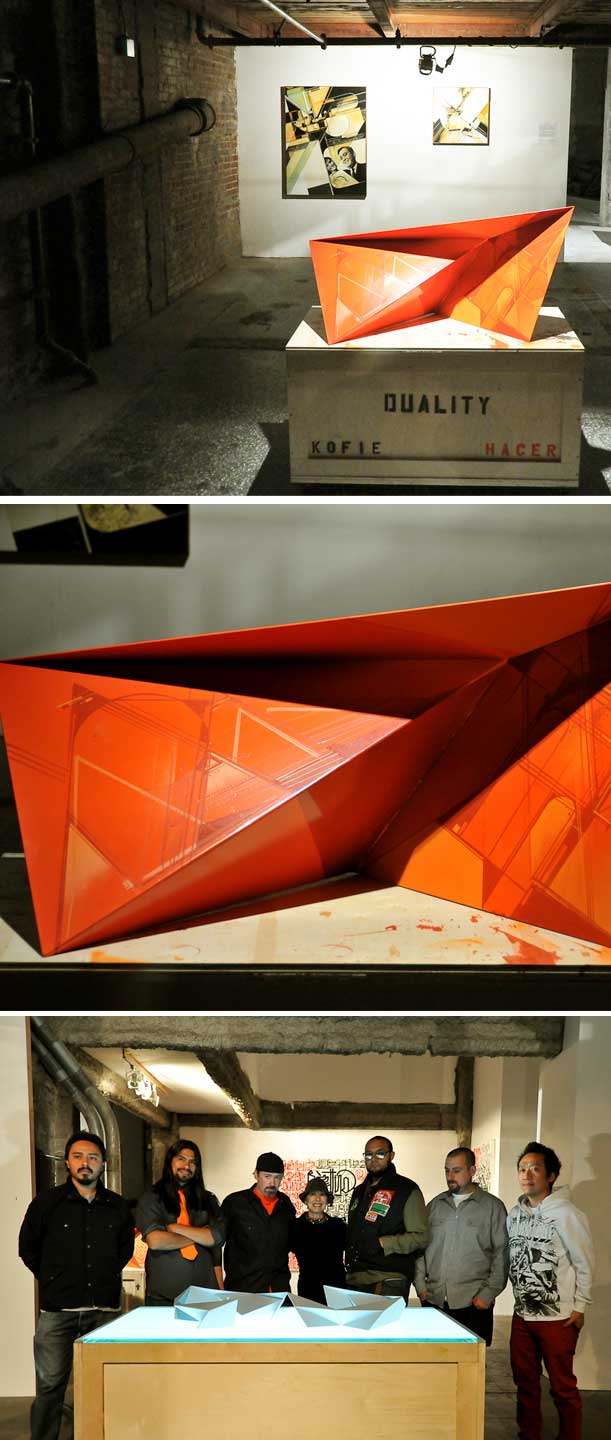Group Exhibition: HACER Presents: DUALITY Exhibition, Downtown LA

………………………………………………………………………………………………………………………………………………………
HACER Presents:
DUALITY
CB GALLERY
408 S. SPRING ST
LA, CA 90012
Public Opening during Artwalk:
THURSDAY, NOV. 11, 2010
6-9 PM
………………………………………………………………………………………………………………………………………………………
Mention of DUALITY on StyleSectionLA
Reaching back to his roots, Hacer has invited both established and emerging graffiti artist contemporaries Retna, Kofie, Saber, Tanner, Sharktoof, Eyeone to engage in a dialogue about the duality inherent in “public” art by making their mark on the inner panels of red-orange [Hacer’s signature color] 1/8 scale, origami-inspired, abstract forms; the full scale versions of which will be publicly installed as a multi-dimensional, Richard Serra-scale wall.
Once installed, the outwardly facing red-orange panels [signifying traditional notions of public art] will stand on the flipside of their inner graffiti-covered equivalents [signifying an equal but yet-to-be embraced form of public art]; creating a legitimate place for the duality of sculpture and graffiti to co-exist .
………………………………………………………………………………………………………………………………………………………
“(It is necessary for artists) to create work on the most visible sides of high modern buildings, in the most artistically strategic places in working-class districts, in Union halls, in public squares, in sports stadia, in open air theaters.” [1](Siqueiros’ 1933 A Call to the Artists of Argentina)
In the very same manner that Siqueiros madea call to artists in Argentina in 1933 to create a mural, Gerardo Hacer reachesback to his graffiti roots and calls established and emerging graffiti artiststo join him in the creation of, “Duality”.
Duality is Hacer’s response to inquiriesinto his “ability to protect the sculpture from graffiti” from local and stategovernment organizations while trying to secure right of entry for installationof his public works.
A former graffiti artist who credits theartform for his development, he responded by inviting graffiti artist s to maketheir mark on the inner panels of one-eighth-scale, red-orange,origami-inspired, abstract forms; the full scale versions of which will bepublicly installed as a multi-dimensional, Richard Serra-scale wall.
Once installed, the outwardly facingred-orange panels [signifying traditional notions of public art] will stand onthe flipside of their inner graffiti-covered equivalents [signifying an equalbut yet-to-be embraced form of public art]; creating a legitimate place for theduality of sculpture and graffiti to co-exist .
Hacer’s choice to embrace graffiti and combine this ancient form of expression with his sculptures, an equally ancientmode, is reminiscent of the Venus of Willendorf’s (sculpture, circa22,000 B.C.E.) co-existence with the Upper Paleolithic cave paintings (theoldest form of graffiti[2]) in the Lascaux and Altamira caves.
Isabel Rojas-Williams
Art Historian-Curator
November 2010
[1] Rochfort Desmond. Mexican Muralists. San Francisco: Chronicle Books, 1998, 148.
[2] Graffiti (Italian plural of graffito/graffio, scratch or scribble), derived from “graph” is based onthe Greek graphein, or “to write,”[2]hence Graffiti’s scratching on walls is not much different from ancientwritings on the walls of sepulchers in the catacombs of Rome or at Pompeii.Graffiti. http://en.wikipedia.org/wiki/Graffiti
………………………………………………………………………………………………………………………………………………………

